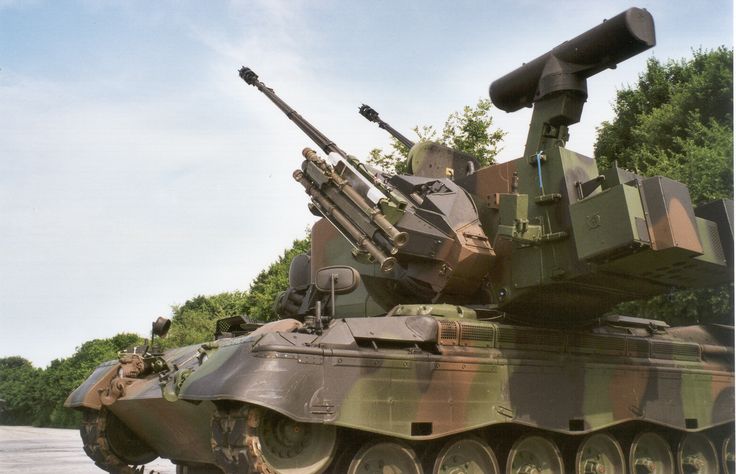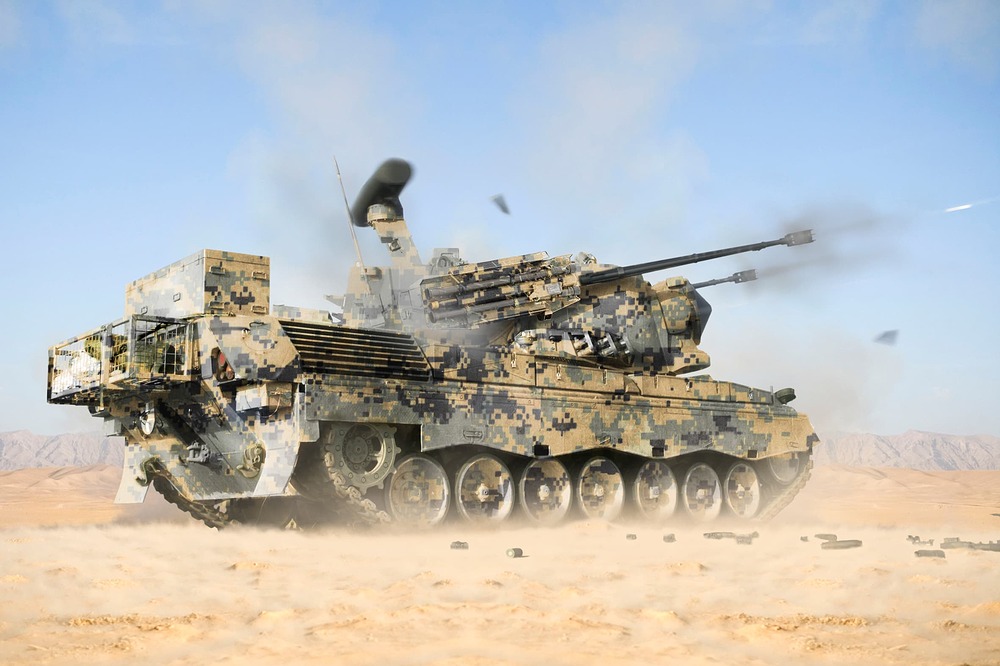- Yes
- No
- (independent) BeNeLux tree
- France: BeNeLux subtree
- Germany
- Dutch (sub) tree
- other
- no/negative
Hello all, this is one of the most iconic Dutch armoured vehicles of the 1990s and the 2000s. Have a read about this improved variant of the Dutch Gepard family. Intended for SHORAD.
TL;DR: The Mid-Life Upgrade of the PRTL CA1.

History
History
In order for the PRTL systems to keep up with time, an improvement programme started in 1985
for the PRTL. This Dutch-German project was first called KWS (Kampfwertsteigerung) and involved a large number of improvements to the PRTL/Gepard, mainly to the radar and fire control systems. For example, an optronic sensor with a laser rangefinder, heat detection and optical tracking capabilities. Externally, not much was to be changed, only the sensors on the barrels were modified, the periscopes and smoke canister installation had been changed and the PRTL was painted in camouflage.After a brief pause in the KWS project, a choice of modifications was made and the
project continued under the name GWI (Gevechtswaarde instandhouding = Combat-worth preservation). The improved smoke canister system and periscopes of the KWS were dropped due to high costs by the Dutch government. The Dutch GWI project afterwards included the following improvements:
To give the crew more storage space for equipment, two crates would be attached to
the tower and one crate on the aft deck.The air-conditioning system for both the crew, and the equipment, would be greatly improved. This is outwardly the biggest difference from the old CA1 PRTL, the air-conditioning unit being a rather large box, which is attached to the tower lower-rear, below the search radar antenna.
Advanced munitions would be used with greater hit probability and greater range. The cartridges have sub-calibre ammunition, meaning that part of the cartridge, after leaving the barrel, is repelled and the core continues to fly at high velocity. Due to the higher ejection speed, of 1.440 m/sec, the cartridge, which incidentally has a charge, has a range of 4,8 km. FAPDS.
Navigation and communication equipment would be greatly improved, making it would have, for example, possibility to exchange data with other radar systems. From the year 2000, GPS (Global Positioning System) will also be included in the PRTL, aka the Target Information Command & Control System (TICCS).
The fire control and radar system had been digitised, this meant the system has a much greater speed and capacity, increasing target effectiveness. The control panels in the tower have undergone many changes. The search radar can be switched off with the antenna still running, so that it does not provide any radiation.
The maintenance and training programme would be modified, using, for example, a special training simulator.
The PRTL-GWI would be fitted with more non-slip treads and a camouflage pattern, similar to the Dutch Leopard-2 battle tank. The standard camouflage colours of the Royal Netherlands Army are bronze green RAL 6031, leather brown RAL 8027 and peat black RAL 9021. The upgrade applies to 60 systems. Delivery of the PRTL-GWI will take place between August 1998 and the end of 2001. Through a rotation system, the ready PRTLs will be gradually be replaced by upgraded pieces, which are now in storage.
Through these improvements, the PRTL should be able to provide adequate protection against air targets. Meanwhile, the designation once given to the Dutch prototype, now in the Army Museum (NMM), has been reinstated. The PRTL-GWI would, in fact, be called `CHEETAH’.
Specifications
Length: 8,15 m
Width: 3,39 m
Height: 2,93 m with radar down; 4,03 m with radar deployedWeight: 47 tons
Engine: 10 cilinder Diesel (860 pk or 610 KW) 37,4 liter MTU (Motoren und Turbinen Union) Type MB 838 CA M500
Speed (on road): 80 km/h (officially 65 km/h)
Range: 550 kmCrew: 3 (commander, driver, gunner)
Armour:
Front Sides Rear Roof 70 mm at 60° 30 mm at 0° 20 mm 25 mm
Armament 2x35mm Oerlikon autocannons Munition types FAPDS [4800 m rage], APFSDS-T [4000m] Ammunition 640 rounds in turret, 20 rounds APFSDS-T Ammunition external extra each per gun (680 total) Fire Rate 1100 rpm (combined) Elevation & Traverse Powered & manual Smoke system 6x2 74mm smoke grenade discharges Fire suppression Automatic Night Vision Yes Fire Control modes (1) Search&Track radar with Datalink TICCS, (2 & 3)Periscope C & G: Passive Optical tracking: 1.5× with a FOV of 50° and 6× magnification with a, narrow, 12.5° FOV. The sights can be guided by both the Search & Trackradar, (4) Observation through the hatch Optical tracking Optical periscope tracking system & the optical target indicator Notes on munition types:
- FAPDS:
This munition was first tested on the CA1 PRTL model, but was offically implemented on the GWI model, as the CA1 would suffer harsh wear and tear when using this munition, leading to needed improvements. The cartridges have sub-calibre ammunition, meaning that part of the cartridge, after leaving the barrel, is repelled and the core continues to fly at high velocity. Due to the higher ejection speed, of 1.440 m/sec. On impact with the target surface, the penetrator breaks into several KE fragments. The round has Frag-HE effects with the higher velocity and flat trajectory of a sabot round. It also has the ability so self-destruct at programmed ranges when linked to the new sensors on the guns and fire-control computer system. This with an increased range of 4800 m. (Tweede Kamer, 1996)
| Designation | Gun | Caliber | Type | Velocity | Weight round | Weight projectile | Weight penetrator | Notes | Range | Fire rate |
|---|---|---|---|---|---|---|---|---|---|---|
| FAPDS-T | 35mm Oerlikon | 35 mm | FAPDS | 1440 m/s | 1,480 kg | 396 g | 298 g | 380 g of TNT | 4800 m | 550 rounds/min |
Radar systems
Search Radar / IFF antenna
- 15 km range
- 60 rpm
- X band (7 to 11.7 gigahertz)
- IFF Mk. X & Mk. XII with SIF
- MTI (digitised)
- GPS integration
- TICCS & Datalink
- Ability to keep running without emmiting radiation (passive detection)
This radar would be capable of even detecting small drones at over 10 km of range, with minimal clutter effect because of its MTI improvement factor. The IFF antenna would also now work without any radiation from the search radar.
Track Radar
- 13 km range
- X (7 to 11.7 gigahertz) and Ka Band (26.5 to 40 gigahertz) [NATO K class]
- IFF/SIF
- TICCS
- Pulse-Doppler / MTI integration digitised
Place in War Thunder
This radar-based Anti-air would serve any tech tree as a good primary or secondairy gun-based air-defence. This SPAA is also a direct upgrade of the CA1 PRTL, which means this could be a researchable modification (like seen with the Tunguska) or a separate vehicle (like seen with the German Gepards).
If both the PRTL CA1 and the PRTL GWI were to be added, these could be foldered, where the CA1 gets HEI-(T)[3500m (self-destruct)], SAPHEI-(T) [3500m (self-destruct)] and APDS-T [3500 m] munitions. And the GWI gets its surperior FAPDS [4800m] and APFSDS-T [4000m] munition.
Regarding nations
Germany
The German KWS-project of KNDS for eventually the 1A2 Gepard is also the same base the GWI-project was designed around, as both the Netherlands and Germany were involved in this program. But these upgrades/MLU were between companies and the governments handled independently with these companies, as these systems were independetly ordered by both nations. When considering technology-based links with already in-game nations Germany has the second biggest claim, after the Netherlands itself.
BeNeLux
As the BeNeLux subtree for France has now been confirmed, France has the highest chance of recieving Dutch equipment. However an independent BeNeLux would also be very possible. For further info please go to: BeNeLux (Belgium, Netherlands & Luxembourg) Ground Forces.
The PRTL would be the token gun-based Short range Anti-air of any BeNeLux or especially a Dutch tech tree.
Pictures
Sources
Sources
- WEG 2011 Vol 2 Airspace and Air Defense Systems p.176 : https://apps.dtic.mil/sti/pdfs/AD1117055.pdf
- Spielberger, W.J., Der Weg zum Flakpanzer Gepard (Munich, 1980). In English translation available in the library of the Army Museum: W.J. Spielberger, Gepard. The history of German anti-aircraft tanks (Munich, 1982).
- Fotoalbums van de grondgebondenluchtverdediging: 35mm PRTL Cheetah : Luchtdoelartillerie (KL/LuA) / Materieel / Wapens / Geschut / 35mm PRTL Cheetah | Fotoalbums van de grondgebondenluchtverdediging
- (Dutch Government: Tweede Kamer der Staten-Generaal/House of Representatives) 24 400 X Vaststelling van de begroting van de uitgaven en de ontvangsten van het ministerie van Defensie (X) voor het jaar 1996:
- nr. 16 BRIEF VAN DE STAATSSECRETARIS VAN DEFENSIE, project «Verbetering luchtverdedigingssysteem Pantserrups tegen luchtdoelen (PRTL): Kamerstuk 24400-X, nr. 16 | Overheid.nl > Officiële bekendmakingen
- nr. 49 LIJST VAN VRAGEN EN ANTWOORDEN: Gevechtswaarde-instandhouding pantserrups tegen luchtdoelen (GWI/PRTL): Kamerstuk 24400-X, nr. 49 | Overheid.nl > Officiële bekendmakingen & https://zoek.officielebekendmakingen.nl/kst-24400-X-49.pdf
- nr. 90 BRIEF VAN DE STAATSSECRETARIS VAN DEFENSIE Gevechtswaarde-instandhouding pantserrups tegen luchtdoelen (GWI/PRTL): Kamerstuk 24400-X, nr. 90 | Overheid.nl > Officiële bekendmakingen
- Netherlands Armed Forces ORDER OF BATTLE 1985 by Hans Boersma: https://www.orbat85.nl
- J. Klomp and H. van Zetten (1998), Army Organic Air Defense: Effectief én betaalbaar na 2000, https://www.militairespectator.nl/sites/default/files/bestanden/uitgaven/1998/1998-0125-01-0032.PDF
- Laatste Cheetah verlaat Nederland: Definitief vaarwel | 08 | Materieelgezien
- KNDS 1A2 Gepard as reference to compare: KNDS Group
- FAPDS-T source: Description and Validation of an Improved Frangible Armour Piercing Munition Model: DTIC ADA274154: Description and Validation of an Improved Frangible Armour Piercing Munition Model : Defense Technical Information Center : Free Download, Borrow, and Streaming : Internet Archive













